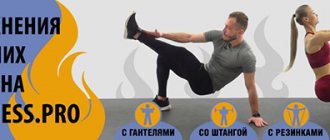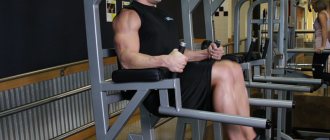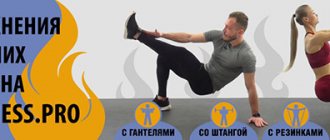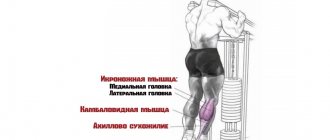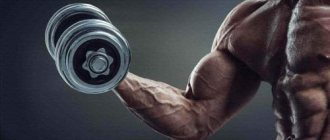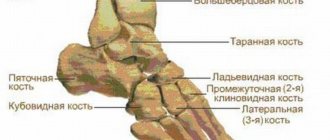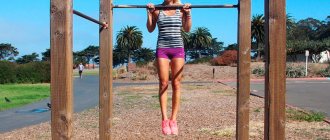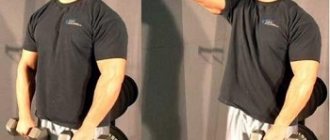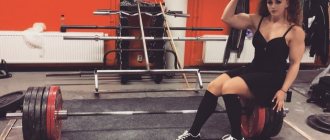The straight leg lift exercise while hanging on a bar (horizontal bar) pumps the lower part of the abs, as well as the rectus femoris muscle. Develops strength and tightens the lower abs.
Hanging leg raises are the most exhausting, but at the same time extremely effective exercise for the abdominal muscles. Perhaps this is the most powerful means of “polishing” the lower abs. However, you can also sharpen your upper abs if you can lift your legs to chest level by rotating your pelvis upward more.
A movement typical of the hanging leg curl, where both the hip joint and the spine are simultaneously flexed, is common in most sports. For example, lifting the leg high up (hitting a flying ball in football, dance steps in gymnastics and acrobatics, kicks in karate) or various variations of jumps with the hips approaching the chest (somersaults and flips in gymnastics, steeplechase, diving, etc.) height and length).
Raising straight legs while hanging on the bar - abdominal exercise
Description and benefits of the exercise
The exercise is done while hanging on a horizontal bar or crossbar. Many gyms have a parallel bars simulator with a backrest. There are three options:
- raising bent knees is the easiest way;
- raising the lower limbs above parallel to the floor is a classic option;
- lifting your legs to the bar is a difficult way.
The peculiarity of raising legs while hanging is that in this way all the abdominal muscles are worked, even the especially complex ones - the lower ones. In addition, including the exercise in the training program will allow you to straighten your posture and usefully stretch the spinal column.
Such training is suitable for people whose bodies are already quite athletically prepared. By performing them, a person can not only achieve beautiful abs, but also develop muscle tone, and at the same time reduce the size of the chest and waist size. The risk of injury is minimal.
Recommendations
When lifting your legs, do not pull yourself up or bend your elbows; they must be kept straight.
To pump up the abs until six-pack appears, exercises are carried out twice a week until the muscles feel a burning sensation.
To increase the load on the abdominal muscles, keep your legs closed.
Trained athletes are advised to additionally weight their lower limbs with special devices or heavy shoes.
If your grip is weak, use hand straps designed for this purpose.
Muscles involved
When lifting your legs to the bar, seven muscle groups are used: two main and five additional.
Basic
When performing the exercise, the main, external and internal oblique abdominal muscles work. They come into action when the lower limbs are raised above an angle of 45°.
There are over 400 muscles in the human body that perform specific functions. Muscle tissue alone accounts for a load of approximately 20 kg, which is 40% of the total mass of the human body. The strongest muscle is the tongue, the fastest is the blinking muscle, the largest is the gluteal.
Additional
Bending the legs is carried out with the help of the hip flexors: pectineus, lumbar minor and major, adductor longus, and rectus femoris. The static load falls on the arms, back and shoulders.
TECHNIQUE
Using the strength of your abdominal muscles, lift your slightly bent legs up so that your toes are at chest level, only after overcoming
parallel to the floor, when the hips rise above their axis, the abs really begin to work. Gently lower your legs down, holding them at a slight angle to contract your abdominal muscles, and lift them up again. When the muscles contract upward, we exhale; when the muscles relax downward, we inhale.
Number of approaches and correct technique
The choice of one of three techniques - simple, classical or complex - depends on the physical preparation of the trainee.
Step 1. In order to perform the exercise correctly, you need to reach the bar and grab it with your palms. Grip – shoulder width apart. The legs should either lightly touch the floor or hang freely. They need to be pulled back a little. This will be the starting position.
Step 2. While inhaling, you should twist your pelvis forward and raise your legs (bent or straight) to the point where they are above parallel to the floor, i.e. The angle between the hips and the body should be less than 90°. You will need to hold in this position for 3-5 seconds. Exhale.
What muscles work
- In addition, the work includes
: deltoid, pectoral, brachioradialis, latissimus muscles. - Loaded:
biceps, triceps, shoulder girdle.
Historically, men work on the horizontal bar, although for girls, practicing on the horizontal bar is no less effective. Classes will help not only to get closer to the treasured six-pack, but also to destroy gender stereotypes in sports.
To make your training productive, it is useful to learn a few rules:
- Before performing exercises on the bar for the press, we warm up the muscles and ligaments. We bend over, swing our legs, squat, rotate our heads and hands.
- To avoid injury, it is important to grip the horizontal bar correctly. We grab the bar with an overhand grip, placing our hands shoulder-width apart. We fix the position with our thumbs from below.
- We follow the rhythm of breathing: as we exhale, we raise our legs, and lower them synchronously with the inhalation.
- Avoid sudden movements and body swaying.
For beginners
It's better to start with . We place a support under the crossbar so that the chin is above the stick. We climb on top, bend our knees and elbows, and lower ourselves. We try to stay suspended for 30 seconds. On a high horizontal bar, you can work with a partner who will hold your hips, helping with the rise. If after 2 weeks of training he still can’t do a pull-up, buy one.
It is important to strengthen your grip strength.
We place our hands in a comfortable position and
hang for 15 seconds (4 sets).
We are constantly increasing our time.
After the muscles have adapted, you can attach a weight to your belt. We select the number of approaches based on personal feelings. The values given below are indicative. For the first time, girls need 3-5 pull-ups
;
men should start with 12 reps. Between sets we pause for 2-3 minutes.
Tips and tricks
Below we give some tips and recommendations on the technique of performing hanging lower limb lifts, which will help to avoid gross mistakes and wasted efforts for beginners and to perform the exercise efficiently for those whose sports training is at an average and higher level.
Basic mistakes of newbies
Beginners tend to make the following mistakes that should be avoided:
- strong swaying of the body and lifting of the lower limbs by inertia - when done this way, the exercise will bring absolutely no benefit;
- relaxation of the muscles of the shoulder girdle;
- helping with hands;
- improper breathing.
To avoid swinging, you need to learn to lower your legs smoothly and pause when they reach the lowest point.
About the features of the exercise and common mistakes:
Execution Features
- When performing the exercise, you can use straps to secure your hands on the bar and elbow clamps. They will help you focus only on your abdominal muscles.
- The hands are not used during execution; they are relaxed and are used only for gripping.
- For maximum load on the oblique abdominal muscles, it is necessary to twist the body left and right - this is done with bent knees, which turn in different directions, rising each time.
- When lifting your legs, you need to tuck your pelvis - this will allow you to maximally tense your abdominal muscles.
- Inertia is unacceptable when performing this exercise. The ankle should rise and fall at each segment of the amplitude in the same amount of time.
- The lowering of the lower limbs should not be carried out completely - they should stop at the level of 15-25°. This way the abdominal muscles will remain tense throughout the entire exercise.
- It is not recommended to attach additional weights to your shins. The legs are a normal load to achieve the desired result.
- The chest must be kept open.
- If you feel pain in the lower back, you need to spread your toes and knees, while leaving your heels closed to each other. This should be more comfortable.
- If you cannot stabilize your body, you can ask a partner or instructor to hold you from behind.
- You need to look straight ahead. The chin resting on the chest is undesirable.
- At the end point of lifting your legs and after fixing them for two seconds, you need to additionally tense your abs.
- For beginners, it will be easier to do lifts of the lower extremities in a vertical position on the Swedish wall or parallel bars with a vertical back.
- The smaller the angle between the body and the hips, the greater the load on the abs.
Raising your legs only parallel to the floor does not give any results to the abdominal muscles. It should be above an angle of 90°. - A reverse grip on the bar is not recommended.
- The main attention should be paid not to raising the lower limbs, but to lowering them.
Execution technique
As already mentioned, the exercise has three degrees of difficulty: simpler (lifting legs with bent knees), classic (legs straight or slightly bent) and more difficult (straight legs raised all the way to the bar).
Let's consider the universal technique of performing the movement, and each athlete determines which variation to choose, depending on his level of physical fitness.
- Starting position – hanging on a bar or horizontal bar with straight arms and legs. The height of the crossbar should be such that your feet either lightly touch the floor or (better) not touch it at all. When performing the exercise, the hands play the role of coupling with the crossbar, that is, they do not participate in the movement. Twist your tailbone slightly forward, feeling that your abs are tense.
- As you exhale, lift your legs and twist your pelvis forward. The angle between your torso and your hips should be less than 90 degrees, regardless of whether you raise your knees or straighten your legs. That is, the hips rise above parallel with the floor, and the pelvis twists forward. By the way, it will be extremely difficult to lift your legs completely straight if you have insufficient stretching of the back of your thighs. Therefore, as a rule, most athletes lift their legs not completely straight, but slightly bent. At the top point, hold for a couple of seconds.
- If possible, slowly lower yourself to the starting position. Perform the required number of repetitions.
The higher you raise your legs, and the straighter your legs are, the greater the load on your abs. Maximum tension of the abdominal muscles will require lifting the legs to the bar itself. In this case, all areas of the rectus abdominis muscles, and not just their lower region, receive significant load.
If you want to additionally load the oblique muscles, add side-to-side trunk crunches, that is, turn your knees to the right and left with each lift.
Aim for at least 15-20 reps in 3-4 sets. This will be difficult at first, so do as many repetitions as you can.
Contraindications
There are no special contraindications to including knee raises or straight leg raises while hanging. It is not suitable for people who:
- lower back problems;
- the ability to stabilize the body is poorly developed;
- the problem area is the shoulder joints;
- there were injuries.
In such cases, it is better to replace the exercise with crunches performed on an inclined bench or reverse crunches performed on the floor.
Hanging leg raises with a ball between the legs[edit | edit code]
HANGING LEG RAISES
Execution
- Hang from the bar, grasping it with an overhand grip slightly wider than shoulder-width apart. Ask your partner to hand you a weighted ball or dumbbell and hold the weight between your feet.
- The exercise will be more targeted if you hang from the bar on hooks or in special “loops”, like a parachutist. This will free your hands from the load and allow you to fully concentrate on working your abdominal muscles.
- Bend your knees and use your abs to lift them as high as possible.
- At the highest point of the lift, take a static pause for a one-two count. Slowly straighten your legs.
Adviсe
- To engage the oblique abdominal muscles in the movement, lift your knees along an inclined path towards your opposite shoulder.
- To make the exercise more difficult, lift your legs straight rather than your knees.
- Ask your partner to lightly rest his palm on your lower back to prevent your body from swaying in time with the lifts.
- Look straight ahead. Don't rest your chin on your chest.
Equipment
- Crossbar
- Hooks, loops (optional)
- Weighted ball or dumbbell
Additional abdominal exercises
When planning hanging leg raises in an abdominal strengthening training program, it should be placed very first, as one of the most difficult. Behind it, place twists, lifts of the legs and body in various ways.
The most effective for the press are:
- hanging knee raises;
- press roller (roller).
Twisting on the floor with straight legs is least effective.
Any exercises designed to pump up the abs give the maximum and fastest effect if performed regularly, correctly, until you feel a burning sensation. Hanging leg raises are one of the most difficult abdominal exercises, but also the most effective. If carried out correctly, muscle strengthening can be felt within 2-3 weeks after the start of training.
Useful tips
One of the first recommendations can be considered the advice not to swing the body too much when performing the movement.
You may want to move your legs back a little at the bottom to help you get through the initial phase of the leg lift, when it's your hip flexors that work more than your abs. But strong swinging and throwing your legs up by inertia will make the exercise a waste of time.
The following points can also be noted:
- Raise your hips above 90 degrees, that is, above a position parallel to the floor.
- Don't forget to tuck your pelvis forward when performing the exercise. It is these additional crunches that will help you maximize the use of your abdominal muscles.
- Work on stretching the back of your legs. This will allow you to perform the exercise with greater amplitude.
In conclusion, it should be noted that any abdominal exercise, be it hanging leg raises, crunches on the floor, in a machine or on a Roman chair, will give an effect if you perform them regularly and until you feel a strong burning sensation in the muscles. Arm yourself with patience, work on yourself and then success will certainly be achieved!
VARIETY OF EXERCISE
1) Raising the legs on a vertical bench - the difference is that the arms do not hang on the crossbar, but rest with the elbows on the soft side supports. Legs are slightly bent at the knees to minimize muscle tension in the lower back.
2) Hanging knee bend – performed if the exercise is difficult or to further shorten a tired muscle. At the top point, raise your knees above your hips, pausing for a second.
3) Raising the legs with rotating the body - everything is similar, only the knees turn to the side, raising the hips, including the transverse, internal and external oblique muscles in the work.
4) High leg raise - a difficult version of the exercise; at the end point of the movement, the legs should touch the crossbar.
5) Raising your legs on special fabric straps - if you have pain in your forearms, injured palms or aching elbows, hang on thick fabric straps, they will help you perform abdominal exercises without loading your forearms.
LEEG RAISES ON THE PULL-UP BAR
1) Don’t let your torso swing, keep it in one position (doesn’t work?, ask your partner to hold your hips so that when you lower your legs down, your torso doesn’t lean back;
2) Raise your legs without a starting jerk, only your abs do all the work;
3) Raising and lowering the legs occurs at the same, slow pace;
4) Do not help lift your legs with your hands; you simply hang on your hands, and your legs and pelvis are lifted solely by the abdominal muscles.
5) Try not to lower your legs to the very end, leaving a small angle of inclination, this forces the abdominal muscles to be in constant tension.
6) If you want to specifically work the lower part of the abs, raise your legs all the way to the bar, this is the most difficult option, but it is the one that loads the lower part of the abdominal muscles well.
